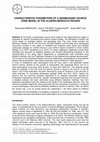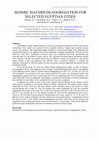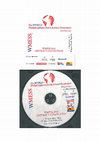Conference Paper by Rashad Sawires

Seismic hazard in terms of mean peak ground acceleration (PGA) and spectral acceleration (SA) val... more Seismic hazard in terms of mean peak ground acceleration (PGA) and spectral acceleration (SA) values has been computed for Egypt using both historical and instrumental earthquake data. In order to carry out this appraisal, a typical zoning method using the CRISIS © software was employed. For this purpose, an updated earthquake catalog, spanning the time period from 2200 B.C. to 2013, has been compiled for Egypt and its surrounding regions, and prepared to be used in a new probabilistic seismic hazard assessment. The earthquakes sizes were unified in terms of the moment magnitude scale and the catalog was declustered. A new seismic source model, for the seismic activity in and around Egypt, consisting of a total of 88 seismic zones (for shallow-and intermediate-depth seismicity) was considered in this new assessment. The seismic parameters have been specifically computed for 35 seismic sources covering the Egyptian territory and the Eastern Mediterranean region. A logic-tree design was setup in order to consider the epistemic uncertainty in the Gutenberg-Richter b-value, maximum expected magnitude (Mmax) and the selected ground-motion prediction equations (GMPEs). Seismic hazard computations, for rock-site conditions, with 10% and 5% probability of exceedance in 50 years were carried out. In addition, uniform hazard spectra for twelve, among the most important and populated cities in Egypt, are computed and compared with the most recent Egyptian building code values. Then the seismic hazard deaggregation results, in terms of distance and magnitude, for the most important cities in Egypt has been performed to help understanding the relative contributions of the different seismic sources. Seismic hazard deaggregation, in particular, was computed for spectral acceleration at period 0, 0.2, 1.0 and 2.0 s for rock-site conditions, and for 10% probability of exceedance in 50 years. It is interesting to highlight that the maximum hazard values are observed at the Gulf of Aqaba region, specifically around the epicentral location of the biggest Egyptian recorded earthquake of 22 November 1995 (MW 7.2) Aqaba earthquake. The obtained seismic hazard values for Nuweiba city (located in this region), for PGA and SA (0.1-s) are 0.29 g and 0.74 g, respectively, for a return period of 475 years. Moreover, the deaggregation results at most of the cities, indicate that the distance to the seismic sources which mostly contributes to the seismic hazard is mainly controlled by the nearby seismic sources (especially for PGA). However, distant events contribute more to the hazard for larger spectral periods (for 1.0 and 2.0 s). A significant result of this type of work is that seismic hazard deaggregation provides useful data on the distance and magnitude of the contributing seismic sources to the hazard in a certain place, which can be applied to generate scenario earthquakes and select acceleration records for seismic design.
Great variations in the representation and values of the earthquake action parameters can be obse... more Great variations in the representation and values of the earthquake action parameters can be observed among the previously published Egyptian building codes −The Regulations of the Egyptian Society of Earthquake Engineering (ESEE, 1988), and the Egyptian Codes for the Calculation of Loads and Forces (ECP-201: 1993(ECP-201: , 2004(ECP-201: , 2008(ECP-201: , and 2011) − during the last three decades.

Some Egyptian building codes have been published in Egypt during the last three decades. These co... more Some Egyptian building codes have been published in Egypt during the last three decades. These codes are the Regulations of the Egyptian Society of Earthquake Engineering (ESEE, 1988), and the Egyptian Codes for the Calculation of Loads and Forces (ECP-201: 1993, 2004, 2008, and 2011). Great variations in the representation and values of the seismic action parameters can be observed among them. The current representation of the seismic action (ECP-201, 2011), which is based mainly on the seismic hazard study done by Riad et al. (2000), and follows the same framework adopted in Eurocode 8 (2004), do not give a specific ground-motion value for each Egyptian city, but it just divides the whole territory of Egypt into six broad zones, assigning to each of them a unique seismic action value. For zones 1, 2, 3 and 4, the peak ground acceleration (PGA) values are 0.10, 0.13, 0.15 and 0.20 g, respectively. Zone 5 is subdivided into two sub-zones, 5a and 5b, with PGA values of 0.25 and 0.30 g, respectively. Recently, an updated probabilistic seismic hazard for Egypt, in terms of PGA and spectral acceleration (SA) values, for both rock and stiff-soil site conditions, has been assessed. Seismic hazard results have been computed for the whole territory, and specific seismic hazard values have been estimated in detail for mostly important cities in Egypt. Moreover, taking into account the noticeable differences among the input seismic actions in the previous building codes, a new approach for establishing the design spectra, using only two SA values for oscillation periods of 0.2 and 1.0 s, is suggested and recommended for the upcoming building code in Egypt. The procedure developed by Malhotra (2005) for the establishment of the design spectra was used here. The obtained design response spectra using this approach have been analysed, comparing it with the computed uniform hazard spectra and the ECP-201 (2011) design spectra for several selected Egyptian cities. It clearly appears that, for a specific location, it is a good approach to include a design spectra defined by only two values (the computed SA values for 0.2 and 1.0 s) in the building code.

In this study, a seismogenic source zone model for the Algeria-Morocco region is proposed for sei... more In this study, a seismogenic source zone model for the Algeria-Morocco region is proposed for seismic forecasting and seismic hazard studies. The delineation includes five zones based on available seismic and geological data. The zone model shown in figure 1, includes the Moroccan Meseta, the Rif, the Tell zone, the High Plateaux and the Atlas zone. Earthquake occurrence process in this region is modeled and analyzed using recent earthquake catalogs for northern Morocco and northern Algeria compiled in former studies (Peláez et al., 2007; Hamdache et al., 2010). For these catalogs, dependent events were identified and removed by adapting Gardner and Knopoff declustering procedure to the study region. Magnitudes of completeness were estimated using different methods, then the Poissonian character of the obtained sub-catalogs was analyzed. The b-value of the Gutenberg-Richter recurrence relationship, considered as an area specific seismic hazard parameter, was initially computed using the Weichert (1980) approach. In order to characterize each seismogenic zone we have introduced a new parameter named seismic activity, defined as the number of earthquakes with magnitude above MW 4.0 in each seismogenic zone since 1925 by each 10 years and 10000 km2. It can be derived that in the Tell seismogenic zone happens of the order of 2.6 events with magnitude above MW 4.0 from 1925, by each decade and by each square cell of 100 km side. The b-value estimation has been improved by using an extension of the Aki-Utsu b-value estimator for incomplete earthquake catalogs (Kijko and Smit, 2012). Taking into account that the maximum possible magnitude is an important parameter required by earthquake engineering community, disaster management agencies and insurance industry, a detailed analysis has been performed using different statistical methods related to the quality of the earthquake data file. As introduced by Kijko (2004) and Kijko and Singh (2011), these procedures are free from subjective assumptions and only depend on seismic data. From a statistical point of view, the estimation methods are divided into three classes: a) parametric procedures, b) non-parametric procedures, and c) based on the fit of the cumulative distribution function of earthquake magnitudes. Thus, the maximum possible magnitude is analyzed at each seismogenic zone and its probability distribution function is derived. Then, we derive the activity rate λ(m) for events above the magnitude m, and the return period for different magnitudes. The analysis has been performed at each seismogenic zone of the proposed model.

The present work concerns with using electrical resistivity, seismicity, and excavating data to i... more The present work concerns with using electrical resistivity, seismicity, and excavating data to investigate the subsurface geological characteristics and their structure and competence for construction purposes at a proposed site in Assiut New City, Egypt. The Dipole-pole configuration was used for the resistivity data acquisition. One-dimensional numerical inversion of individual DC resistivity was applied to enhance the processing of the results for better achievement of the study aims. Models obtained from the 2D inversion of each station for constructing geo-electric sections which exhibit the main geo-electric characteristics of the shallow geological units and their heterogeneities in the site. Furthermore, a proposed seismic source model and its related seismicity parameters have been employed in seismic hazard assessment study for the investigated area. The interpreted geoelectrical sections show three-four layers. Their structure and lateral variation were resolved. Also, the competence of layers for civil engineering foundation was revealed from seismicity parameters investigation.

In this study, a seismogenic source zone model for the Algeria-Morocco region is proposed for sei... more In this study, a seismogenic source zone model for the Algeria-Morocco region is proposed for seismic forecasting and seismic hazard studies. The delineation includes five zones based on available seismic and geological data. The zone model includes the Moroccan Meseta, the Rif, the Tell zone, the High Plateaux and the Atlas zone. Earthquake occurrence process in this region is modelled and analyzed using recent and updated earthquake catalogs for northern Morocco and northern Algeria compiled in former studies (Peláez et al. 2007; Hamdache et al. 2010). For these catalogues, dependent events were identified and removed by adapting Gardner and Knopoff declustering procedure to the characteristics of the study region. Magnitudes of completeness were estimated using different methods, then the Poissonian character of the obtained sub-catalogs was analyzed. The b-value of the Gutenberg-Richter recurrence relationship, considered as an area-specific seismic hazard parameter, was initially computed using the Weichert (1980) approach. In order to characterize each seismogenic zone we have used a new parameter named seismic activity, defined as the number of earthquakes with magnitude above Mw 4.0 in each seismogenic zone since 1925 by each 10 years and 10000 km 2. The obtained results show for example, in the Tell zone, the seismic activity is equal to 2.6 and1.91 in the Rif region. The b-value estimation has been improved by using an extension of the Aki-Utsu b-value estimator for incomplete earthquake catalogs (Kijko and Smit, 2012). Taking into account that the maximum possible magnitude is an important parameter required by earthquake engineering community, disaster management agencies and insurance industry, a detailed analysis has been performed using different statistical methods, free from subjective assumptions and only related to the quality of the earthquake data file. Thus, the maximum possible magnitude, using parametric and non-parametric procedures, is analyzed at each seismogenic zone and its probability distribution function is derived. Then, we derive the activity rate m for events above the magnitude m , the return period for different magnitudes and the probability of exceeding a magnitude m during a time period of T years. The analysis has been performed at each seismogenic zone of the proposed model.

Se ha calculado la peligrosidad sísmica para Egipto en términos de la aceleración horizontal máxi... more Se ha calculado la peligrosidad sísmica para Egipto en términos de la aceleración horizontal máxima (PGA) y la aceleración espectral (SA). Para ello, se ha compilado un catálogo de terremotos actualizado para Egipto y regiones cercanas, abarcando desde el año 2200 a. C. hasta el 2013. Las magnitudes se unificaron utilizando la escala de magnitud momento. También se consideró en esta evaluación un nuevo modelo de fuentes sísmicas a la hora de caracterizar la actividad sísmica en Egipto y su entorno. Los parámetros sísmicos se han calculado específicamente para 35 nuevas fuentes cubriendo el territorio egipcio y el este del Mediterráneo. Además, se estableció un modelo de árbol lógico, para incluir la incertidumbre epistémica, en el que se consideraron el valor de b y la máxima posible magnitud en la relación de Gutenberg-Richter, y las ecuaciones de predicción del movimiento del suelo consideradas. Se llevó a cabo el cálculo de la peligrosidad sísmica para roca, y para un 10% y 5% de probabilidad de superación en 50 años. Además, se calcularon espectros uniformes de respuesta para las más importantes ciudades, comparándolos con los que aparecen en el actual código de construcción egipcio. Los máximos valores de peligrosidad se observan en el Golfo de Aqaba, específicamente en el entorno de la localización epicentral del terremoto de mayor magnitud registrado, el terremoto de Aqaba (7.2 M W ) de 22 de Noviembre de 1995. Los valores obtenidos en Nuweiba (localizada en esta región) para la PGA y la SA (0.1 s) son, para un período de retorno de 475 años, 0.29g y 0.74g, respectivamente.

Since October 2012 till now, more than 2200 low magnitude earthquakes have been located in the vi... more Since October 2012 till now, more than 2200 low magnitude earthquakes have been located in the vicinity of the towns of Torreperogil and Sabiote (Jaén), in the easternmost part of Guadalquivir Basin, Spain, an area considered of low seismic hazard. Specific tectonic studies in the region are barely available due to the scarce deformation of Mesozoic and Cenozoic cover. However, the re-interpretation of former seismic reflection profiles reveals blind faults in the Variscan basement that could host the swarm. In this work we show the characteristics of the seismic series, including the relocation of earthquakes with magnitude above m bLg 1.5 using the well-known HypoDD code. In addition to a disperse seismicity composed by very low magnitude events that could not be relocated, two clear seismicity clusters with different characteristics were observed. Both clusters showed an approximate N-S striking, probably related to two N-S striking structures. Additionally, we also assessed a statistical analysis of the sequence. The detailed survey carried out in the epicentral area verified the existence of some fault zones. Although it is also possible to observe dip-slip movements, the main zone shows a tectonic fabric with lateral sense of shearing. Their strike and kinematics are in agreement with one of the two nodal planes of the computed focal mechanism.

In this study, a seismogenic source zone model for the Algeria-Morocco region is proposed for sei... more In this study, a seismogenic source zone model for the Algeria-Morocco region is proposed for seismic forecasting and seismic hazard studies. The delineation includes five zones based on available seismic and geological data. The zone model shown in figure 1, includes the Moroccan Meseta, the Rif, the Tell zone, the High Plateaux and the Atlas zone. Figure 1. Map showing the five seismogenic zones included in the proposed model Earthquake occurrence process in this region is modeled and analyzed using recent earthquake catalogs for northern Morocco and northern Algeria compiled in former studies (Peláez et al., 2007; Hamdache et al., 2010). For these catalogs, dependent events were identified and removed by adapting Gardner and Knopoff declustering procedure to the study region. Magnitudes of completeness were estimated using different methods, then the Poissonian character of the obtained sub-catalogs was analyzed. The b-value of the Gutenberg-Richter recurrence relationship, considered as an area-specific seismic hazard parameter, was initially computed using the Weichert (1980) approach.

Probabilistic seismic hazard analysis in terms of peak ground acceleration (PGA) and spectral acc... more Probabilistic seismic hazard analysis in terms of peak ground acceleration (PGA) and spectral acceleration (SA) values was assessed for the Egyptian territory. Eighty-eight potential seismic sources (for shallow-and intermediate-depth seismicity) in and around Egypt were identified and characterized based on an updated and unified earthquake catalogue spanning the time period from 2200 B.C. until 2013. Earthquake recurrence rates were computed, from both instrumental and historical data, for the defined seismic sources. Six well-known ground motion attenuation models were selected to predict the ground motion for the different tectonic environments in and around Egypt. Finally, a logic tree approach was followed, after a sensitivity analysis, to consider the epistemic uncertainty in different inputs (b-value, maximum expected magnitude and ground motion attenuation model). In the present study, we show the seismic hazard deaggregation results, in terms of distance and magnitude, for the most important cities in Egypt to help understanding the relative contributions of the different seismic sources. Seismic hazard deaggregation for PGA, 0.2, 1.0 and 2.0 s SA, for 10% probability of exceedance in 50 years (return period of 475 years), was computed in detail. The deaggregation graphs were drawn considering bins of 0.5 for magnitude and 25 km for distance. The mean and modal values of magnitude and distance, to identify the distribution of control earthquakes that contribute to exceedance of the considered SA level were also computed. In general, the results at most of the cities, indicate that the distance to the seismic sources which mostly contributes to the seismic hazard is mainly controlled by the nearby seismic sources (especially for PGA). However, the more distant events contribute more to the hazard for larger spectral periods (for 1.0 and 2.0 s SA). For instance, the control earthquake for Cairo has a moment magnitude (MW) values in the range 5.0-5.5 and a focal distance between 0 and 25 km for PGA, 0.2, and 1.0 s SA, whereas for 2.0 s the distance remains the same but the magnitude become 6.0-6.5. However, for Port Said (located along the Mediterranean Sea coast), values of 7.0-7.5 MW and 375-400 km for the control earthquake has been obtained for all spectral periods. A significant result of this type of work is that seismic hazard deaggregation provides useful data on the distance and magnitude of the contributing seismic sources to the hazard in a certain place, which can be applied to generate scenario earthquakes and select acceleration records for seismic design.

A new and updated probabilistic seismic hazard assessment has been conducted for Egypt. To carry ... more A new and updated probabilistic seismic hazard assessment has been conducted for Egypt. To carry out this appraisal, new data and models has been incorporated, as well as a new treatment of the involved uncertainties in this type of studies. An updated and unified earthquake catalogue (2200 BC -2013) has been compiled specifically for this assessment. A new seismic source model has been developed, including 28 shallow seismic zones (h < 35 km) for the Egyptian territory and its surroundings, 53 shallow seismic sources (h < 20 km) for the Eastern Mediterranean region after Seismic Hazard Harmonization in Europe (SHARE) project, and 7 intermediate seismic sources (20 < h < 100 km) covering the intermediate-depth seismicity in the Eastern Mediterranean region. These seismic sources were defined including all available data, some of them specifically compiled for this work (seismicity and focal mechanism catalogues). After a sensitivity analysis, a logic tree design was used in order to consider the epistemic uncertainty both in the b-value and the maximum expected magnitude of the Gutenberg-Richter recurrence relationship, as well as in the ground motion attenuation model. Using the CRISIS 2014 software, seismic hazard computations for rock site conditions and different return periods were performed. Here we show some of these results, in fact, peak horizontal ground acceleration (PGA) and spectral acceleration (SA) values for spectral periods of 0.2 and 1.0 s, and for return periods of 475 and 975 years. Moreover, uniform hazard spectra (UHS) have been computed specifically for some selected cities. All these results are compared with those included in the current Egyptian regulation. Maximum hazard values are obtained at Nuweiba city, located at the Gulf of Aqaba, around the location of the November 22, 1995, Mw 7.2 Aqaba earthquake. Values of 0.74 g and 0.98 g for a spectral period of 0.1 s, are obtained for return periods of 475 and 975 years, respectively. In Cairo, computed maximum values are 0.32 g and 0.44 g for the same return periods, also obtained for a spectral period of 0.1 s.
Objectives: Seismic hazard in terms of mean peak ground acceleration (PGA) and spectral accelerat... more Objectives: Seismic hazard in terms of mean peak ground acceleration (PGA) and spectral acceleration (SA) values has been computed for Egypt using both historical and instrumental earthquake data. In order to carry out this appraisal, a typical zoning method using the CRISIS © software was employed.

Probabilistic seismic hazard analysis in terms of peak ground acceleration (PGA) and spectral acc... more Probabilistic seismic hazard analysis in terms of peak ground acceleration (PGA) and spectral acceleration (SA) values was assessed for the Egyptian territory. Eighty-eight potential seismic sources (for shallow-and intermediate-depth seismicity) in and around Egypt were identified and characterized based on an updated and unified earthquake catalogue spanning the time period from 2200 B.C. until 2013. Earthquake recurrence rates were computed, from both instrumental and historical data, for the defined seismic sources. Six well-known ground-motion attenuation models were selected to predict the ground motion for the different tectonic environments in and around Egypt. Finally, a logic-tree approach was followed, after a sensitivity analysis, to consider the epistemic uncertainty in different inputs (b-value, maximum expected magnitude and ground-motion attenuation model). In the present study, we show the seismic hazard deaggregation results, in terms of distance and magnitude, for the most important cities in Egypt to help understanding the relative contributions of the different seismic sources. Seismic hazard deaggregation for PGA, 0.2, 1.0 and 2.0 s SA, for 10% probability of exceedance in 50 years (return period of 475 years), was computed in detail. The deaggregation graphs were drawn considering bins of 0.5 for magnitude and 25 km for distance. The mean and modal values of magnitude and distance, to identify the distribution of control earthquakes that contribute to exceedance of the considered SA level were also computed. In general, the results at most of the cities, indicate that the distance to the seismic sources which mostly contributes to the seismic hazard is mainly controlled by the nearby seismic sources (especially for PGA). However, the more distant events contribute more to the hazard for larger spectral periods (for 1.0 and 2.0 s SA). For instance, the control earthquake for Cairo has a moment magnitude (MW) values in the range 5.0-5.5 and a focal distance between 0 and 25 km for PGA, 0.2, and 1.0 s SA, whereas for 2.0 s the distance remains the same but the magnitude become 6.0-6.5. However, for Port Said (located along the Mediterranean Sea coast), values of 7.0-7.5 MW and 375-400 km for the control earthquake has been obtained for all spectral periods. A significant result of this type of work is that seismic hazard deaggregation provides useful data on the distance and magnitude of the contributing seismic sources to the hazard in a certain place, which can be applied to generate scenario earthquakes and select acceleration records for seismic design.











Uploads
Conference Paper by Rashad Sawires